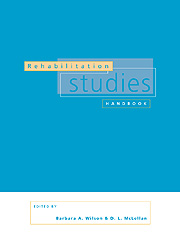Book contents
- Frontmatter
- Contents
- List of contributors
- 1 Introduction to rehabilitation
- 2 Disabled people in society
- 3 Disability equality training
- 4 Towards a therapeutic alliance model of rehabilitation
- 5 Rehabilitation education: a learner-centred approach
- 6 Work, occupation and disability
- 7 Management in rehabilitation
- 8 Research and evaluation in rehabilitation
- 9 Statistical methods
- 10 Social policy, disability and rehabilitation
- 11 Principles of the acquisition of sensorimotor skills
- 12 Management of acquired cognitive disorders
- 13 Challenging behaviour: helping people with severe brain damage
- 14 Pain
- 15 The multiply handicapped child
- 16 The transition to adult life
- 17 Factors specific to disabled elderly people
- Index
3 - Disability equality training
Published online by Cambridge University Press: 06 November 2009
- Frontmatter
- Contents
- List of contributors
- 1 Introduction to rehabilitation
- 2 Disabled people in society
- 3 Disability equality training
- 4 Towards a therapeutic alliance model of rehabilitation
- 5 Rehabilitation education: a learner-centred approach
- 6 Work, occupation and disability
- 7 Management in rehabilitation
- 8 Research and evaluation in rehabilitation
- 9 Statistical methods
- 10 Social policy, disability and rehabilitation
- 11 Principles of the acquisition of sensorimotor skills
- 12 Management of acquired cognitive disorders
- 13 Challenging behaviour: helping people with severe brain damage
- 14 Pain
- 15 The multiply handicapped child
- 16 The transition to adult life
- 17 Factors specific to disabled elderly people
- Index
Summary
Introduction
The primary focus of this chapter is to describe the philosophy behind Disability Equality Training (DET) and its use in challenging employment discrimination. DET is a short training programme of one or two days that has been developed by disabled people for employers. The training aims to provide delegates with an understanding of the social model of disability. This will help them improve their organisations' policies and procedures in order to reduce the impact of institutional discrimination on disabled applicants and employees.
Previous alternative attempts to reduce this discrimination have not worked. Legislation which has imposed a quota of disabled people on employers and attitude modification programmes designed in the USA have failed to combat discrimination. Alternative approaches are needed (Duckworth, 1995). This chapter introduces one such approach that is based on the social model of disability. This model rejects the assumption that employment discrimination results solely from the negative attitudes of employers as being too simplistic. It favours viewing discrimination as a process institutionalised within social organisation.
Initially the experience of discrimination is considered with reference to the changing nature of work. Then the construction of the ‘disability category’ is described with regard to the development of the social model of disability as based on the underlying ideology. The utility of the social model in challenging employment discrimination is considered by contrasting its application with the individual (medical and tragedy) model. Next the social model is developed to suggest a new and probably more realistic reason for the failure of the quota scheme. This discussion concludes by presenting a new definition of disability.
- Type
- Chapter
- Information
- Rehabilitation Studies Handbook , pp. 45 - 74Publisher: Cambridge University PressPrint publication year: 1997



